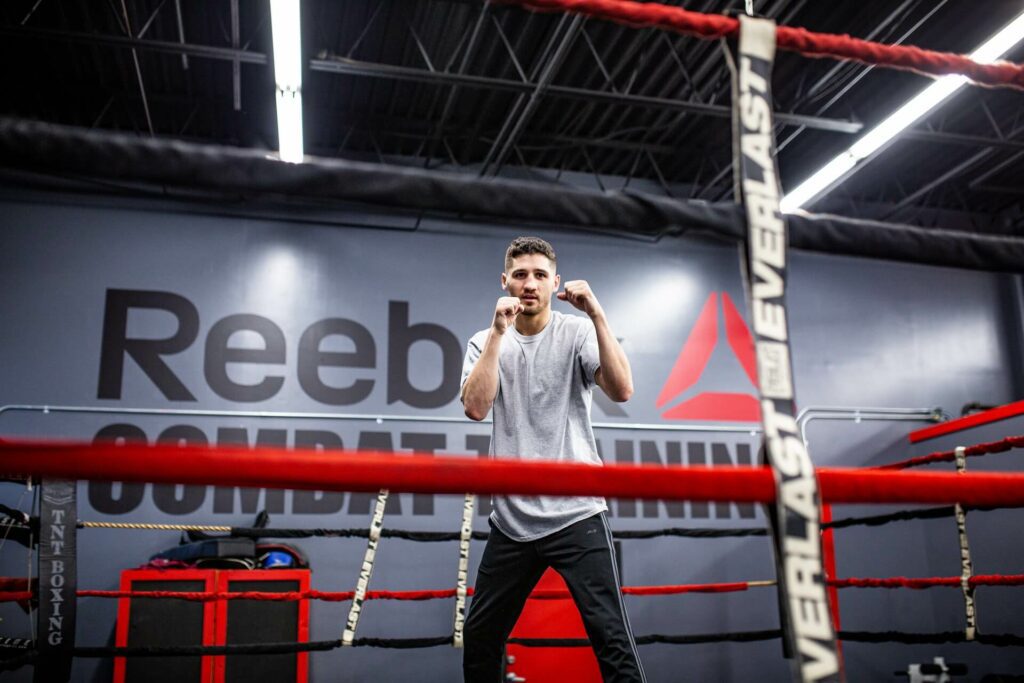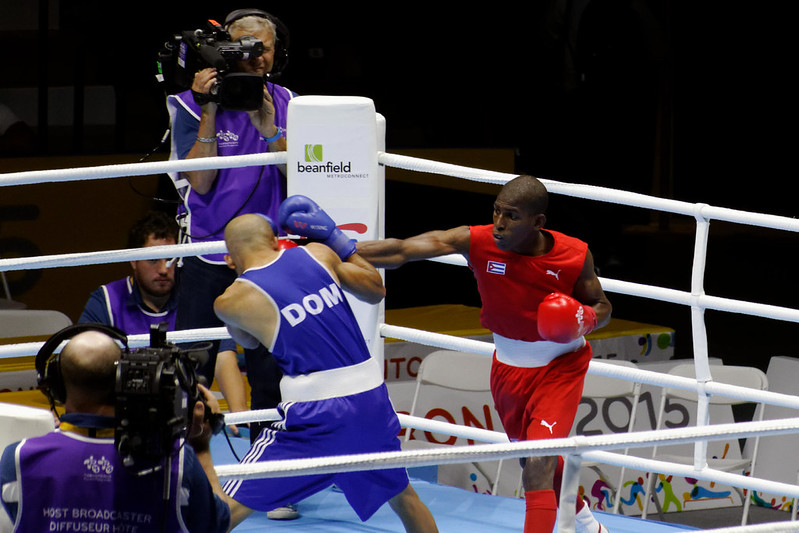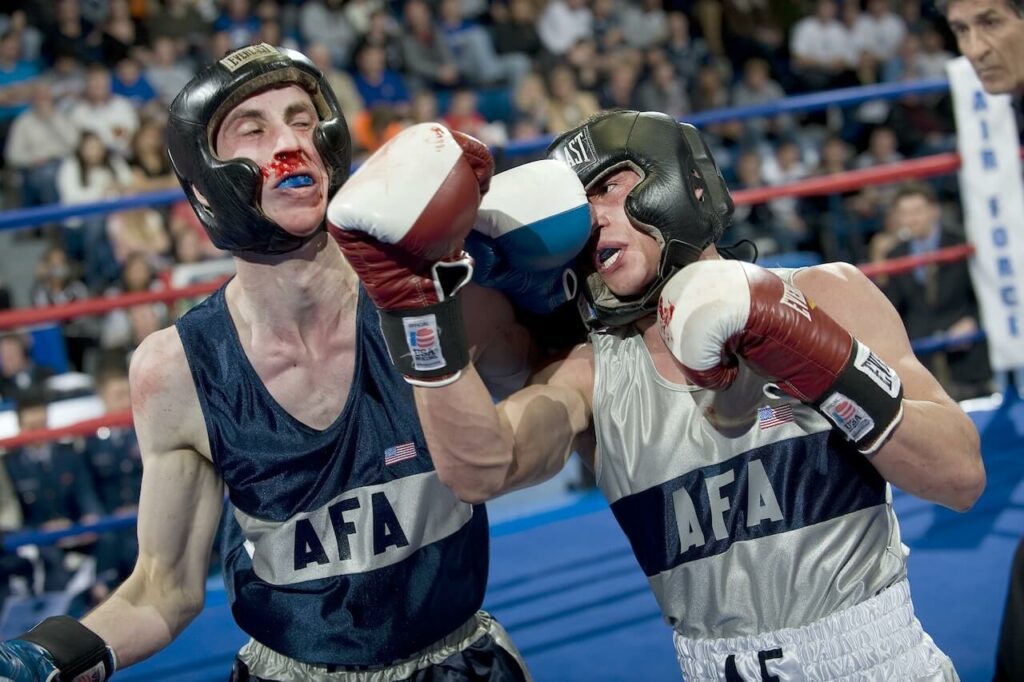Introduction
There is an informal vocabulary to boxing, and each word represents a whole meaning. Every boxer and boxing fan must be familiar with it. Here we will review all the important words and their meanings in boxing. This vocabulary will be updated frequently. Make sure you bookmark this page.
Punches
- Cross – Back hand (rear hand) straight punch
- Uppercut – A punch that comes from beneath, which could be with the left hand or right.
- Hook – A punch that is thrown to the sides. The arm shape and punch are as of a hook. It could be with the left or right hand.
- Lead hand – The front hand of the boxer.
- Overhand right/left – Powerful punch that is thrown in a circular motion over the top of the opponent’s guard.
- Power jab – A jab with force behind it, intended to hurt and not just back off or measure the distance from the opponent.
- Feinting – The act of faking a punch, showing the intent of throwing it with body language but not throwing it.
- Check hook – A hook thrown by a boxer while moving backward or sideways to evade an opponent’s attack. Combination – A quick series of punches.
Gym And Training
- Old-school boxing – Referred to the boxing era of the 19th century, usually as of comparison to boxing today. Old-school boxing is known for its different breeds of fighters. The different mentality fighters had back then, the focus on physical fitness and discipline, classical techniques, and odd training methods compared to today’s training methods.
- New school boxing – Refers to today’s boxing, the techniques and style, training methods, and fighters.
- Spar – A simulation of a fight between two boxers but for the matter of learning and preparing for a “real” fight and wearing more padded gloves and headgear, while both fighters are going more “easy” on each other.
Styles And Boxer Description
- Orthodox boxer – Slang for a boxer whose lead hand is the left hand.
- Soviet-style – A style of the soviet union countries, a style of outside fighting, combinations, and movement. Read more here.
- Mexican-style – A style of Mexican fighters, an aggressive and close-ranged fighting style, includes power punches and pressure on the opponent. Read more here.
- Cuban-style – A style of Cuban boxers, a defensive style that involves moving and slicking punches similar to “dancing in the ring”. Read more here.
- Philly shell – A boxing style while the lead hand protects the body and the backhand protects the chin, also known because Floyd Mayweather jr. mastered this style.
- Out-boxer – A boxer that will fight mostly at the “outside”, keeping the opponent at a distance and throwing punches from far, usually long jabs and crosses. Read about other types here.
- Inside-boxer – A boxer that will fight mostly at close range, keeping the opponent close to him and throwing combinations and power punches at close range.
- Head hunter – Refers to a boxer whose main focus is the head and ignores body punches.
- Glass chin – Describes a boxer that cannot take a punch and last or gets knocked out easily.
- Pound for pound – A term that refers to a theoretical comparison between two boxers that are in different weight divisions, but if they were in the same weight, who would be the stronger and more skilled boxer?.
- Pound for pound best – Someone that is referred to as the best boxer among all weights, usually considered because of skills, resume, strength, and overall ability in the ring.
Technique
- “Cut the distance” – Getting close to the opponent in a safe manner while ducking and dodging incoming punches.
- “Cut the ring” – Making the opponent’s movement limited and not allowing him to move as he wishes, usually done for ring control and setting up punches.
- “Touch him with a jab” – Throw a jab just to check the distance, stop the opponent from getting close with a jab, or block his vision with a jab.
- Bob and weave – Move up and down and side to side quickly to avoid being hit.
- Rolling with the punches – A defensive technique, moving with the punches or moving the punch direction to reduce their impact.
- Slipping – The action of moving the head to avoid being hit.
- Clinching – The act of boxers when they hold each other to prevent an exchange. This is usually used to slow the action, break the rhythm, or when one of the boxers is hurt to “steal” time for recovery.
- High guard – Describing a guard type with the boxer’s hands that covers the facial area while leaving the belly area open. More here.
Fighting
- Amateur boxing – A competitive boxing match of 3 rounds, usually as part of a tournament, with padded gloves according to the weight division of the boxers.
- Professional boxing – A competitive boxing match of 12 rounds, each of the boxers is shirtless and usually wears 10oz gloves during the match.
- Round – A three-minute of action.
- Ring – A slang for the boxing square.
- Ropes – Referred to the ropes of the ring.
- Break – A call by the referee to stop and step back both fighters, usually in a situation of a clinch.
- Stop – A call by the referee to stop the fight for a moment, for example: stop for an inspection by a doctor on a boxer, usually because of cuts or other medical considerations, one of the boxer’s mouthpieces fell off, for a points deduction, etc.
- Bell – Refers to the sound of the bell at the opening and closing of a round.
- Time – Refers to when the referee calls the end of the round.
- Below the belt/Low blow – Describing a punch below the belt level, usually to the sensitive area or legs.
- Cutman – The person in the boxer’s corner that is responsible for checking and caring for any cuts and swellings that could affect the boxer from continuing the fight.
- Hand-wrapper – The person that is responsible for the boxer’s hand-wrapping.
- Corner – One of the four vertices of the ring.
- Staying off the ropes – Refers to not fighting near the ropes but away from them (To provide better exit options from punches and fighting range).
- The center of the ring – Refers to the middle of the ring.
- Work the body – Refers to punching the body of an opponent in order to exhaust and fatigue him.
- Gassed – Refers to a boxer that is out of stamina and is exhausted.
- Punch set-up – Refers to providing a pre-preparation for a punch, for example, jabbing the body two times in a row in a short period of time, but in the third time a boxer is about to attack, he will feint the jab to the body and throw a jab to the head. This is called setting up a jab to the head.
- Hit the canvas – This usually refers to when a boxer gets hit and gets knocked down or knocked out in the ring.
- Challenger – A boxer that is facing a champion for his title.
- Champion – A boxer that holds a title.
- Knockdown – When a boxer falls to the ring floor after being hit and touching the canvas with his gloves or knees.
- Lineal champion – Refers to a boxer that won a title from another boxer who won the title, and the title has been passed down through a chain of champions one after another.
- “His out” – Usually refers to a boxer that is knocked out.
- Toe to toe – A term that describes a close-range fight when both boxers won’t back down, and exchange punches repeatedly.
- Go to the distance – Refers to a fight that went to the late rounds or the entire 12 rounds.




